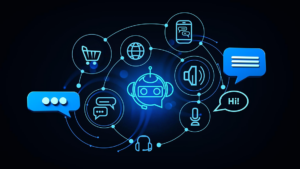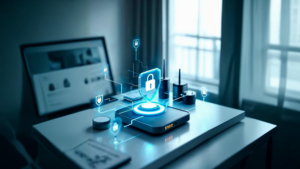

ACL Digital
The Impact of 5G and Edge Computing on Different Industries
Many have considered 5G and Edge computing to be independent. But 5G is heavily reliant on Edge Cloud to provide the results linked with the latest generation of mobile network technology. Industry insiders opine that both technologies are ready to substantially enhance application performance and support large amounts of data to be processed in real-time. The prime reason for using edge computing in 5G is to minimize round-trip data latency between the mobile network core, mobile clients, and cloud computing resources.
5G – the next generation of mobile connectivity can create impact and enormous value for different industries and society. The impact will be augmented by understanding that 5G is not just a faster version of 4G. However, when it comes to speed, latency, and throughput, 5G signifies a generational leap in cellular technology. Advanced uses of this unique technology show great potential in a wide range of settings such as ambulances that communicate with doctors, smartwatches, hospitals equipped with 5G devices, cars, wearables, digital wallets that connect phones, and other devices. Furthermore, when 5G is utilized with edge computing, it will empower businesses and society to achieve the full benefits of these technologies.
ACL Digital’s Edge cloud framework helps build edge computing infrastructure while reducing the latency of services offered from the cloud. From core network design & development services to edge network deployment services and more, you can depend on us to deliver end-to-end 5G innovative solutions.
Next-Generation Technologies
5G is poised to push our data transfer abilities to an all-different level, and edge computing’s most important benefit is its capability to enhance networking performance by reducing latency.
Like 5G, edge computing is not a solo technology but a combination of technologies implemented to accomplish a business result. However, to achieve this scale, required with edge deployments, white box hardware will play a crucial part. When both these technologies are paired together, the resulting application can transform experiences and products differently altogether.
Opportunities and the Way Ahead
At times, 5G and Edge are used interchangeably, but the fact remains that both these technologies are quite different. While Edge use case can also be done in 4G, it is completely independent of 5G. However, 5G will offer an entirely new set of opportunities or use-cases that never existed in a 4G environment.
A typical example would be a use-case that existed in 4G, but it may not have those network slicing features, those latencies, nor bandwidths. Because of these reasons, its ability to be impactful or powerful would be limited. But 5G will transform it in the coming days as it is the fuel for edge computing.
From improving crop and livestock management to enabling robotic surgery, Edge computing and 5G is primed to disrupt the world’s major industries such as:
- Healthcare
- Manufacturing
- AR/VR
- Cloud Computing
- Retail
- Gaming
- Agriculture
- Energy & Utilities
- Financial Services
- Media & Entertainment
- Transportation
- Education
- Public Safety
- Supply Chain Management
- Marketing & Advertising
- Military
- Insurance
- Real Estate
- Tourism
- Restaurants
Below are Some of the Use Cases
Healthcare
Edge is substantially reforming the healthcare industry. The technology promises to make healthcare delivery better, cheaper, and easier for everyone. In the current scenario, Edge computing can turn out to be important, where doctors can observe and examine the vitals of patients from remote locations and come up with an appropriate action plan. Not only that, but Edge computing devices are also widely utilized to monitor patients, enhance the speed and precision of diagnosis, and even trace the delivery of vaccine supply.
Let’s take a look at some of the advantages Edge computing offers in healthcare:
- Efficient handling of latency and downtimes
- Real-time analytics and data processing
- Security to identify breaches and better control over data
- Adhering to regulatory compliance to keep patient information close to source
- Scrutinizing and consequent action on crucial vitals in remote areas
- Wearable devices can help healthcare companies save business costs due to surveillance and security
There is a massive potential of 5G to drive more revenue into the healthcare ecosystem that includes hardware, software, connectivity, and solutions. Healthcare is perhaps the foremost beneficiary of better data and AI over any other sector. Whether in the community, or the hospital, patients can be supervised continually via sensors that gather and examine health vitals and alert doctors and caregivers. Devices may include heart monitors, glucometers, oximeters, blood pressure cuffs, and other smart wearables. High-tech hospitals can also track the live location and performance of their medical equipment. The results of these innovations can include superior care, improved quality of life at a lower cost. Meanwhile, health clinics and hospitals can get better value from expensive assets with less downtime.
Also, the digitized healthcare industry has done an incredible job during this pandemic by helping patients and providers with virtualized and remote care. The popular belief is that 5G will help track infections across the population and offer real-time data that can reduce the spread and safeguard health workers.
Retail
The introduction of Edge computing has transformed the retail industry to a great extent. Retailers collect a lot of data about their customers, both external and internal. The touchpoint is the cashier with all the customer information. E.g., Like what the customer has bought, at what price, and when, and how often they buy a product. When you look at a supermarket, you see a vast collection of products, and at times, certain things are not captured accurately. So, you can use smart devices in different areas of the store and collect those touchpoints and understand your customer behaviour more thoroughly. The advantage of Edge computing comes from the power of personalization, where you want to sell to everybody but with a distinct and precise customer experience.
Touted as the next big technology, 5G will drive advanced technologies with reliability, speed, muster more data and finally help build long-lasting relationships. According to a recently published report, the shift to digital shopping has leapfrogged by as much as five years. Customers can now use products before they buy, thanks to AR applications. Also, they would be able to view additional on a product by just pointing their smartphones at it. Moreover, retail businesses will also benefit from smart parking allocation systems that will help prospective customers in urban areas. Also, 5Gs’ enhanced connectivity will boost the findings of local businesses from the customers’ smart devices. By removing any performance issues, it is possible to make those gateway services much stronger and more appealing.
Manufacturing
The manufacturing sector is one of the most favourable Edge computing use cases, where new technologies may likely lead to substantial productivity gains. The strengths of the Edge computing framework are its ability to lower the intricacy of interconnected systems, making it easier to gather and examine data in real-time. It can also allow smart devices to collect important information in inaccessible regions where network connectivity is unreliable or not cost-effective. Combining Edge computing and Smart IoT devices will make it easier to enhance supply chains and simplify industrial processes.
The decentralized nature of Edge computing applications can significantly reduce start-up time and costs for industrial companies setting up new manufacturing units or expanding operations. Smart devices used to monitor temperature, motion, and climate sensors that can adjust cooling and lighting plus other environmental controls can make the most effective use of electricity.
Across the globe, manufacturing companies are facing the heat to deliver products at lower prices and more quickly. Moreover, most manufactured products are turning out to be more complex. Simultaneously, some of the industries have an ageing labour force and are worried about skills drain.
Many industry experts anticipate that 5G will bring in automation that will make processes economical and more efficient, leading to Smarter factories or industrial establishments. Also, AR empowered by 5G will bring a lot of advantages for manufacturers, and open additional opportunities for remote maintenance and digital twins. Business models that leverage 5G can make use of benefits such as:
- Improves security
- Real-time control
- Automated operations
- Works remotely
- Run applications on the edge
- Brand new business models
- Analytical/predictive in approach
Conclusion
The earliest adopters of edge computing and 5G technology will be manufacturing, Smart homes, fleet management, smart cities, entertainment, and logistics. Whereas, transportation, automation, energy, fintech, and utility sectors will follow in the next couple of years. According to reports from industry experts, over 90% of industrial organizations will use the 5G edge-ecosystem by 2022. Many companies are heavily investing in 5G networks to make their business networks more cost-efficient. When edge computing’s low latency processing capabilities and the speed of 5G is combined, companies can realize an efficient, agile, and IoT driven future.
Is your company ready for the change? With ACL Digital’s innovative technological solutions, you can be well-prepared for the next wave of technology needs, services, and the business environment way before your competitors. To learn more, get in touch with ACL Digital today.



